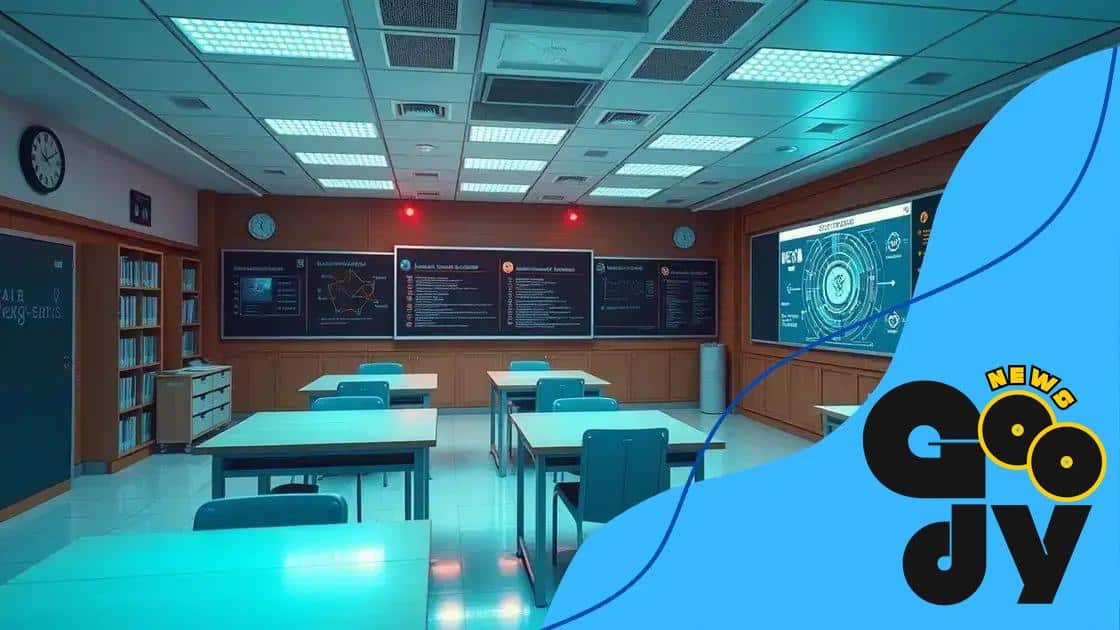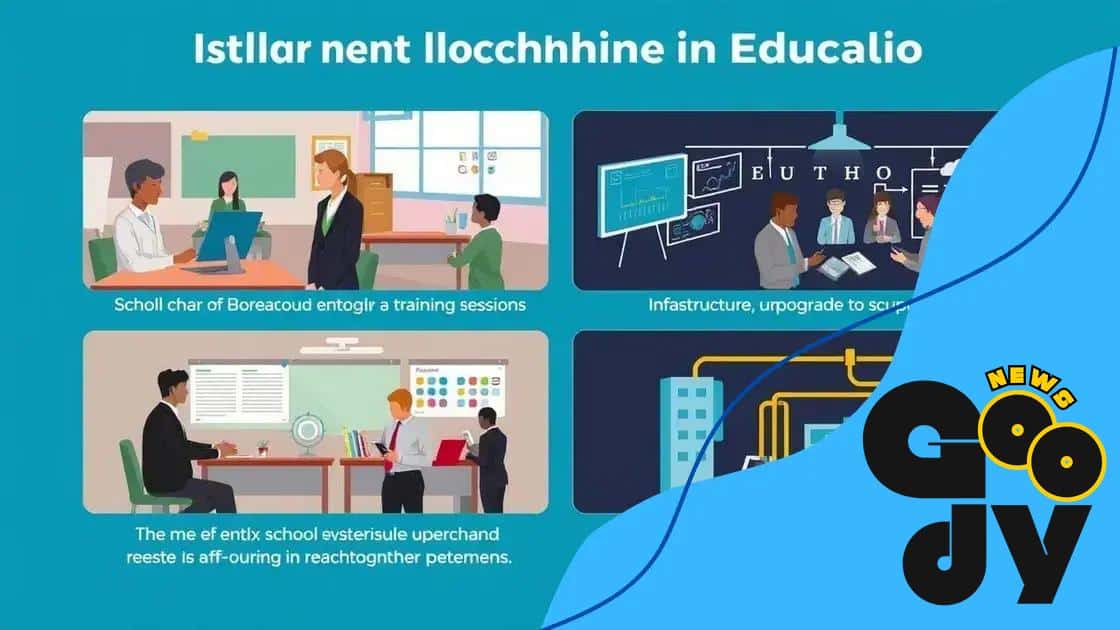Blockchain for secure student records: A game changer

Blockchain for secure student records enhances data security, transparency, and accessibility, allowing students to manage their credentials efficiently while preventing fraud and fostering trust between educational institutions and employers.
Blockchain for secure student records is becoming a hot topic in education. Have you considered how this technology could transform how schools handle data? Let’s explore its potential.
Understanding blockchain technology
Understanding blockchain technology is essential in today’s digital world. This technology has the potential to revolutionize how we manage data, particularly in education.
What is Blockchain?
Blockchain is a system that records information in a way that makes it difficult or impossible to change, hack, or cheat the system. It is a digital ledger of transactions maintained across multiple computers. This ensures everyone has access to the same information, making it transparent and secure.
Key Features of Blockchain
- Transparency: Everyone can see the data, which builds trust.
- Security: The use of cryptography protects information from unauthorized access.
- Decentralization: There is no central authority controlling the data, which enhances safety.
- Immutability: Once recorded, transactions cannot be easily altered.
The decentralized nature of blockchain means no single entity has control. This is crucial for managing student records, as it protects sensitive information from being compromised. By leveraging blockchain, schools can securely store student achievements, certifications, and personal data.
Imagine a world where students own their educational data. With blockchain, they can share their records with universities or employers without worrying about them being altered or misused. This is a game changer in how we approach record keeping in education.
Understanding how this technology works can empower educational institutions to utilize it effectively. Adopting blockchain can lead to better data management practices, ensuring that student records are more secure than ever before.
Benefits of blockchain for student records
The benefits of blockchain for student records are numerous. It brings a new level of security and accessibility in managing educational data.
Enhanced Security
With traditional record keeping, student data is often vulnerable to breaches. Blockchain offers enhanced security through its decentralized structure. This means there is no singular point of failure, making it harder for hackers to access sensitive information.
Accessibility and Control
Students will have greater accessibility to their records, allowing them to control who sees their data. This gives them the power to share information on their terms, whether with an employer or another institution.
- Easy Verification: Employers can quickly verify a candidate’s credentials.
- Fraud Prevention: Reduces instances of diploma mills and fraud.
- Instant Access: Reduces the time it takes to request and obtain transcripts.
Implementing blockchain technology can make the entire process more efficient. Schools can easily update records and students can instantly share them, streamlining communications. This efficiency not only helps students but also saves resources for educational institutions.
Moreover, since records are stored on a public ledger, it promotes transparency. Everyone involved can track changes and access records securely, fostering trust between students and institutions.
In addition to security and efficiency, blockchain enhances the integrity of student records. Each transaction is time-stamped and linked to the previous one, making it nearly impossible to alter records without a trace. This increases accountability and reinforces the value of academic achievements.
Challenges in implementing blockchain in education

There are several challenges in implementing blockchain in education, despite its many benefits. Recognizing these challenges is essential for successful adoption.
Resistance to Change
Many educational institutions are accustomed to traditional methods of record keeping. This resistance to change can slow down the adoption of blockchain technology. Educators and administrators may feel unsure about how to integrate this new system.
Technical Complexity
The technical aspects of blockchain can be daunting. Understanding how to set up and maintain a blockchain system requires technical expertise. Schools may not have the staff needed to manage such systems effectively.
- Training Needs: Staff must be trained to use blockchain technology.
- Investment Costs: Implementing blockchain can require significant upfront costs.
- Infrastructure Requirements: Upgrading technology infrastructure may be necessary.
Another challenge is the need for collaboration among various stakeholders. Schools, students, and employers must work together to ensure that the program meets everyone’s needs. This collaboration takes time and effort to establish.
Additionally, there are legal and regulatory concerns associated with blockchain usage. Compliance with data protection laws is critical. Educational institutions need to navigate these laws carefully to avoid any legal issues.
Finally, there’s the issue of public awareness. Many people are still unfamiliar with blockchain technology. Promoting understanding and acceptance can help ease concerns and make implementation smoother.
Real-world examples of blockchain applications
Real-world examples of blockchain applications are increasingly evident across various industries, showcasing the technology’s versatility. Education is one area ripe for transformation.
Educational Credentialing
Many universities are beginning to use blockchain for storing and verifying student credentials. For instance, institutions like MIT have issued digital diplomas on a blockchain. This allows graduates to easily share verified credentials with employers or other schools.
Secure Student Records
Some schools are implementing blockchain to manage student records securely. This helps in keeping transcripts, attendance, and other personal data safe from tampering. By using blockchain, schools can ensure students have immediate access to their records.
- DigiCert: A platform that provides verified digital identity and trust solutions.
- Chalkboard: A service that enables schools to manage data securely via blockchain.
- Blockcerts: An open standard for creating, issuing, viewing, and verifying blockchain-based credentials.
Additionally, some educational startups are exploring how blockchain can facilitate lifelong learning. Individuals can earn, maintain, and showcase their skills and achievements over their lifetime in a secure manner.
Internationally, nations like Malta and the United Arab Emirates are also exploring blockchain for education. These countries are creating national frameworks to integrate blockchain into their educational systems. This can enhance collaboration, transparency, and trust among educational institutions.
Moreover, blockchain can support micro-credentialing initiatives. This approach allows students to receive certifications for specific skills and achievements, showing that they are continuously learning and adapting.
Future of blockchain in student data management
The future of blockchain in student data management looks promising. This technology is set to revolutionize how educational institutions handle sensitive information.
Increased Adoption
As more schools recognize the benefits of blockchain, we can expect an increased adoption in the coming years. Institutions will leverage decentralized systems to create secure, tamper-proof records. This shift can lead to a new standard in how student data is handled.
Personalized Learning Experiences
Blockchain can help create personalized learning experiences for students. By giving students control over their data, they can share relevant information with educators and employers. This will enable tailored educational pathways. With a digital wallet, students can store certifications and skills, enhancing their job prospects.
- Seamless Transfers: Students can transfer records between institutions without delays.
- Data Integrity: Verification of degrees and achievements will become straightforward.
- Global Accessibility: Students can have access to their information from anywhere in the world.
Moreover, blockchain can facilitate real-time tracking of academic progress. Students, parents, and educators can monitor achievements and set goals collaboratively. This approach encourages accountability and ensures a strong support system for learning.
As we look ahead, integrating blockchain into student data management will likely address many current challenges. Institutions will be able to cut costs associated with traditional data management, and students will have more ownership of their academic records. This empowerment can lead to improved outcomes and greater trust in educational credentials.
FAQ – Frequently Asked Questions about Blockchain in Education
What are the main benefits of using blockchain for student records?
The main benefits include enhanced security, transparency, easier access, and improved personalized learning experiences.
How does blockchain improve data security in education?
Blockchain uses encryption and a decentralized structure, making it nearly impossible for unauthorized access or tampering with student information.
Can students easily share their credentials with potential employers?
Yes, blockchain allows students to own and easily share their verified educational credentials with employers without delays.
What challenges do schools face when implementing blockchain technology?
Schools may encounter resistance to change, technical complexity, investment costs, and regulatory concerns during implementation.





